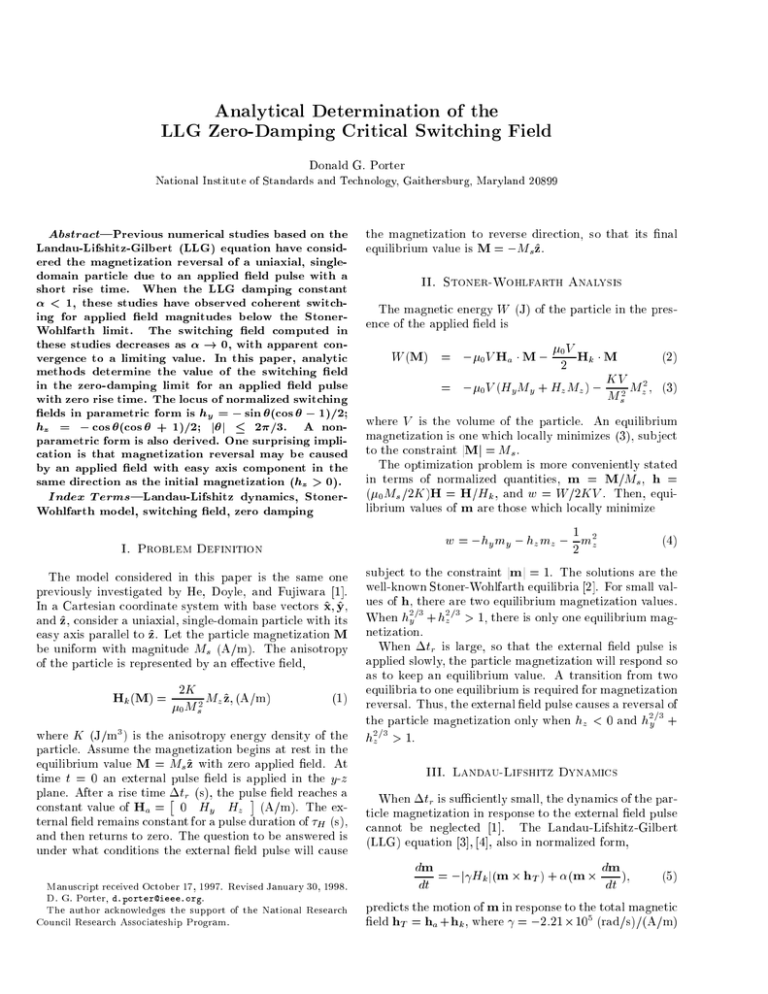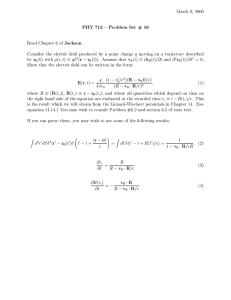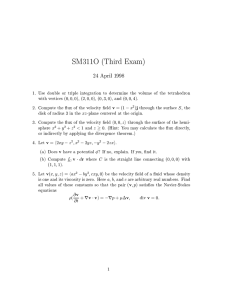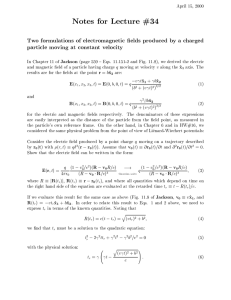Analytical Determination of the LLG Zero
advertisement

Analytical Determination of the
LLG Zero-Damping Critical Switching Field
Donald G. Porter
National Institute of Standards and Technology, Gaithersburg, Maryland 20899
Abstract|Previous numerical studies based on the
Landau-Lifshitz-Gilbert (LLG) equation have considered the magnetization reversal of a uniaxial, singledomain particle due to an applied eld pulse with a
short rise time. When the LLG damping constant
< 1, these studies have observed coherent switching for applied eld magnitudes below the StonerWohlfarth limit. The switching eld computed in
these studies decreases as ! 0, with apparent convergence to a limiting value. In this paper, analytic
methods determine the value of the switching eld
in the zero-damping limit for an applied eld pulse
with zero rise time. The locus of normalized switching
elds in parametric form is hy = ? sin (cos ? 1)=2;
hz = ? cos (cos + 1)=2; jj 2=3. A nonparametric form is also derived. One surprising implication is that magnetization reversal may be caused
by an applied eld with easy axis component in the
same direction as the initial magnetization (hz > 0).
Index Terms|Landau-Lifshitz dynamics, StonerWohlfarth model, switching eld, zero damping
I. Problem Definition
The model considered in this paper is the same one
previously investigated by He, Doyle, and Fujiwara [1].
In a Cartesian coordinate system with base vectors x^; y^,
and ^z, consider a uniaxial, single-domain particle with its
easy axis parallel to ^z. Let the particle magnetization M
be uniform with magnitude Ms (A/m). The anisotropy
of the particle is represented by an eective eld,
K M ^z; (A=m)
Hk (M) = 2M
2 z
0
s
(1)
where K (J/m3 ) is the anisotropy energy density of the
particle. Assume the magnetization begins at rest in the
equilibrium value M = Ms^z with zero applied eld. At
time t = 0 an external pulse eld is applied in the y-z
plane. After a rise time tr (s), the pulse
eld reaches a
constant value of Ha = 0 Hy Hz (A/m). The external eld remains constant for a pulse duration of H (s),
and then returns to zero. The question to be answered is
under what conditions the external eld pulse will cause
Manuscript received October 17, 1997. Revised January 30, 1998.
D. G. Porter, d.porter@ieee.org.
The author acknowledges the support of the National Research
Council Research Associateship Program.
the magnetization to reverse direction, so that its nal
equilibrium value is M = ?Ms^z.
II. Stoner-Wohlfarth Analysis
The magnetic energy W (J) of the particle in the presence of the applied eld is
W (M) = ?0 V Ha M ? 02V Hk M
(2)
2
= ?0 V (Hy My + Hz Mz ) ? KV
Ms2 Mz ; (3)
where V is the volume of the particle. An equilibrium
magnetization is one which locally minimizes (3), subject
to the constraint jMj = Ms .
The optimization problem is more conveniently stated
in terms of normalized quantities, m = M=Ms, h =
(0 Ms =2K )H = H=Hk , and w = W=2KV . Then, equilibrium values of m are those which locally minimize
(4)
w = ?hy my ? hz mz ? 21 m2z
subject to the constraint jmj = 1. The solutions are the
well-known Stoner-Wohlfarth equilibria [2]. For small values of h, there are two equilibrium magnetization values.
When h2y=3 + h2z=3 > 1, there is only one equilibrium magnetization.
When tr is large, so that the external eld pulse is
applied slowly, the particle magnetization will respond so
as to keep an equilibrium value. A transition from two
equilibria to one equilibrium is required for magnetization
reversal. Thus, the external eld pulse causes a reversal of
the particle magnetization only when hz < 0 and h2y=3 +
h2z=3 > 1.
III. Landau-Lifshitz Dynamics
When tr is suciently small, the dynamics of the particle magnetization in response to the external eld pulse
cannot be neglected [1]. The Landau-Lifshitz-Gilbert
(LLG) equation [3], [4], also in normalized form,
dm = ?jH j(m h ) + (m dm );
k
T
dt
dt
(5)
predicts the motion of m in response to the total magnetic
eld hT = ha + hk , where = ?2:21 105 (rad/s)/(A/m)
is the gyromagnetic ratio and is a dimensionless phenomenological damping parameter. During the interval
tr < t < tr + H , the external eld pulse has the
constant value ha , and the rate of energy dissipation is
dw = ?h dm = ?h m dm :
T
T
dt
dt
dt
(6)
Only the second term of (5), the damping term, contributes to the energy dissipation rate. The rate of energy
dissipation can be controlled by selecting the value of the
damping parameter . When the values of both and
tr are small, the increase in magnetic energy due to the
application of the external eld pulse outpaces the dissipation of energy and the trajectory of m is not conned
to equilibrium values.
Solutions to (5) in terms of the spherical coordinates
of m [5] were computed numerically by He, Doyle, and
Fujiwara [1] for several values of tr < 10 ns, and several
values of . They determined that the non-equilibrium
trajectories of m allowed magnetization reversal by coherent rotation to occur at smaller applied eld magnitudes than predicted by Stoner-Wohlfarth analysis. For
> 1, the energy dissipation rate is rapid enough that
Stoner-Wohlfarth analysis computes the correct value for
the critical magnitude of the external eld pulse required
for magnetization reversal for each applied eld direction.
For each rise time tr and applied eld direction, as decreases < 1, the critical eld magnitude required for
magnetization reversal decreases. As ! 0, a limiting
value for the critical switching eld is reached. In the
next section, analytic methods are used to determine that
limiting value, the zero-damping critical switching eld.
IV. Zero-Damping Switching Field
When = 0 in (5), the damping term disappears and
the rst term, the precession term, may be expanded,
1 dm = (m h ? m h ? m m )x^
(7)
jHk j dt
z y
y z
y
z
+ (mxhz + mx mz )y^ ? mx hy^z:
As the magnetization follows the trajectory determined
by (7), there is no energy dissipation, so all points on
that trajectory satisfy
w(t) = ?hy my (t) ? hz mz (t) ? 21 m2z (t) = w(tr ) (8)
for tr < t < tr + H .
Assume tr = 0. Recall that mz = 1 at t = 0, so (8)
becomes
?hy my (t) ? hz mz (t) ? 12 m2z (t) = ?hz ? 21 ; (9)
or
(10)
my = ? 2h1 (mz ? 1)(mz + 2hz + 1);
y
the equation of a parabola, considered as a function of mz .
The precession trajectory of constant energy is that portion of the intersection of this parabola with the sphere
jmj = 1 which includes the point m = ^z. The inter-
section can take the form of two closed curves, each surrounding one Stoner-Wohlfarth equilibrium, or a single
closed curve, similar to the stitches on a baseball, which
surrounds both Stoner-Wohlfarth equilibria. Of course,
when the applied eld is large enough that there is only
one Stoner-Wohlfarth equilibrium, the intersection is a
single closed curve which surrounds that equilibrium.
For any small, positive value of , the magnetization
trajectory will depart the constant energy trajectory and
spiral toward a Stoner-Wohlfarth equilibrium surrounded
by the constant energy trajectory. Assume a small positive value for and a value for H large enough that it
does not inuence the nal value of m. When there is only
one equilibrium surrounded by the constant energy trajectory, there is no uncertainty about the nal magnetization
value. However, when both equilibria are surrounded by
the constant energy trajectory, the spiraling magnetization trajectory could lead to either one, depending on the
precise value of . Thus, magnetization reversal is possible whenever the constant energy trajectory surrounds
both Stoner-Wohlfarth equilibria.
If the constant energy trajectory surrounds both
Stoner-Wohlfarth equilibria, it must also surround the
saddle point in the energy surface which separates them.
That
saddle point
occurs at a magnetization m =
mx my mz , which is a stationary point of the
equations of motion. Thus,
mz hy ? my hz ? my mz = 0;
(11)
mxhz + mx mz = 0;
(12)
mx hy = 0:
(13)
To determine whether the constant energy trajectory surrounds one or two equilibria, we may test whether it surrounds the saddle point. Those constant energy trajectories which surround the saddle point are separated from
those which do not by the boundary case of those constant energy trajectories which intersect the saddle point.
Clearly the saddle point lies in the y-z plane (mx = 0),
and we may write
my = sin ;
(14)
mz = cos :
(15)
The values of h for which the constant energy trajectory
intersects the saddle point are determined by nding the
common solutions of (9) and (11),
hy = ? sin (cos ? 1)=2;
(16)
hz = ? cos (cos + 1)=2;
(17)
where jj < 2=3.
Fig. 1 illustrates the critical switching elds for the two
extreme cases. When tr is large or > 1, the StonerWohlfarth assumptions are valid, and the normalized external eld pulse must lie in the region below the solid
curve in order to cause magnetization reversal. When
tr = 0, H is large, and the normalized external eld
pulse lies below the dashed curve, there exists some small
1.5
Stoner−Wohlfarth switching field
1
Zero−damping switching field
z
h
0
−0.5
−1
−1
−0.5
0
hy
k
?
0.5
−1.5
−1.5
1 dm 2 =
H dt 0.5
1
1.5
Fig. 1. For slowly applied eld pulses, or large damping, StonerWohlfarth analysis predicts magnetization reversal only for normalized applied elds below the solid curve. For an instantly applied
eld pulse and zero damping, magnetization reversal may occur for
normalized applied elds below the dashed curve.
positive value of for which magnetization reversal will
occur. Intermediate cases of short, but non-zero, tr or
larger values of still less than 1 have switching elds
between these two limiting curves, and can be calculated
by the numerical methods of He, Doyle, and Fujiwara [1].
As observed in other numerical computations by He and
Doyle [6], [7], when is small the magnetization may oscillate back and forth across the x-y plane several times
before reaching an equilibrium. Whether or not reversal
occurs depends on which side of the x-y plane the magnetization is on when its energy falls below that of the
energy barrier. Dierent values of will yield dierent
outcomes.
One surprising conclusion to be drawn from Fig. 1 is
that magnetization reversal may be caused by an external eld pulses of appropriate magnitude applied on the
same side of the hard plane as the initial magnetization,
providedp the eld is applied at an angle greater than
tan?1 3 3 from the easy axis.
V. Non-Parametric Expression
Given an applied eld (hy ; hz ), it is not easy to use (16)
and (17) to determine if the switching eld is exceeded
because they are in terms of the unknown parameter . A
non-parametric expression for the zero-damping switching
eld is desirable.
Consider the squared magnitude of (7). This quantity is
non-negative, and equals zero only at stationary points of
the motion of m. Substitution of the constraints jmj = 1
and the constant energy trajectory (9) yields an expression,
h2y ? hz ? 14 + 2hz mz (18)
hz ? 21 m2z ? 41 m4z :
The zero-damping switching elds are those values of
(hy ; hz ) for which the constant energy trajectory intersects a saddle point. That is, the constant energy trajectory contains a point at which (18) must equal zero. This
point is clearly a minimum of (18), which is easily computed. An equation for the zero-damping switching eld
is the equation which sets the minimum value of (18) to
zero. The solution is
h2y = 81 + 52 hz ? h2z + 81 (1 ? 8hz )3=2 ;
(19)
for ?1 < hz < 1=8.
VI. Conclusions
Analytic methods have conrmed the nding of previous numerical studies that coherent magnetization reversal can be predicted by the LLG equation for applied eld
pulses with magnitude below the Stoner-Wohlfarth limit.
The necessary conditions are short rise time of the applied eld pulse, and suciently small damping parameter
that the rate of energy increase due to the applied eld
outpaces the rate of energy dissipation due to the LLG
damping term. Both parametric and non-parametric expressions for the switching eld in the limit of zero rise
time and zero damping have been derived. These analytical solutions have utility as test cases for the verication
of numerical solvers.
References
[1] L. He, W. D. Doyle, and H. Fujiwara, \High speed coherent switching below the Stoner-Wohlfarth limit", IEEE Trans.
Magn., vol. 30, no. 6, pp. 4086{4088, November 1994.
[2] E. C. Stoner and E. P. Wohlfarth, \A mechanism of magnetic
hysteresis in heterogeneous alloys", Proc. R. Soc., vol. A240,
pp. 599, 1948.
[3] L. Landau and E. Lifshitz, \On the theory of the dispersion of
magnetic permeability in ferromagnetic bodies", Physikalische
Zeitschrift Der Sowjetunion, vol. 8, pp. 153{169, 1935.
[4] T. L. Gilbert, \A Lagrangian formulation of the gyromagnetic
equation of the magnetization eld", Physical Review, vol. 100,
no. 4, pp. 1243, November 1955.
[5] P. R. Gillette and K. Oshima, \Magnetization reversal by rotation", J. Appl. Phys., vol. 29, pp. 529{531, 1958.
[6] L. He and W. D. Doyle, \A theoretical description of magnetic switching experiments in picosecond eld pulses", J. Appl.
Phys., vol. 79, no. 8, pp. 6489{6491, April 1996.
[7] L. He, W. D. Doyle, L. Varga, H. Fujiwara, and P. J. Flanders,
\High-speed switching in magnetic recording media", Journal
of Magnetism and Magnetic Materials, vol. 155, pp. 6{12, 1996.



